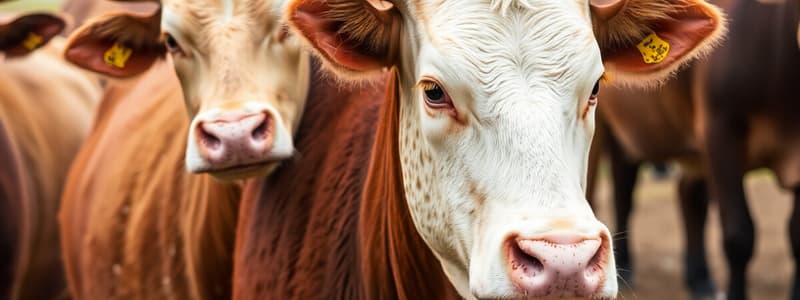Podcast
Questions and Answers
A dairy farmer notices that a cow is not exhibiting oestrus behavior despite being midway through her typical 21-day cycle. Which hormonal imbalance is the MOST likely cause?
A dairy farmer notices that a cow is not exhibiting oestrus behavior despite being midway through her typical 21-day cycle. Which hormonal imbalance is the MOST likely cause?
- Sustained high levels of progesterone preventing the onset of oestrus. (correct)
- Elevated levels of prostaglandin F2alpha (PGF2α) prematurely regressing the corpus luteum.
- An excessive surge of luteinizing hormone (LH) causing premature ovulation.
- Consistently low levels of follicle-stimulating hormone (FSH) inhibiting follicular development.
Following ovulation in a cow, which of the following occurs due to the influence of luteinizing hormone (LH)?
Following ovulation in a cow, which of the following occurs due to the influence of luteinizing hormone (LH)?
- Regression of developing follicles and a decrease in estrogen production.
- Release of prostaglandin F2alpha (PGF2α) to trigger the next oestrous cycle.
- Maturation of the endometrium to prepare for implantation.
- Development of the corpus luteum and increased progesterone secretion. (correct)
If fertilization does NOT occur in a cow, what hormonal event initiates the subsequent oestrous cycle?
If fertilization does NOT occur in a cow, what hormonal event initiates the subsequent oestrous cycle?
- The developing follicles increase secretion of progesterone to maintain the uterine lining.
- The corpus luteum begins to produce estrogen, stimulating oestrus behavior.
- The pituitary gland increases production of luteinizing hormone (LH), triggering ovulation.
- The uterus releases prostaglandin F2alpha (PGF2α), causing corpus luteum regression. (correct)
During artificial insemination, semen is typically deposited into the uterus of the cow. Which layer of the uterine wall plays the MOST direct role in sperm transport to the oviducts?
During artificial insemination, semen is typically deposited into the uterus of the cow. Which layer of the uterine wall plays the MOST direct role in sperm transport to the oviducts?
In a cow experiencing prolonged period of non-cycling (high progesterone levels), which treatment would be MOST effective in initiating the oestrous cycle?
In a cow experiencing prolonged period of non-cycling (high progesterone levels), which treatment would be MOST effective in initiating the oestrous cycle?
A veterinarian is examining a cow experiencing difficulty conceiving. Upon ultrasound, she observes underdeveloped uterine horns. Which of the following could explain this?
A veterinarian is examining a cow experiencing difficulty conceiving. Upon ultrasound, she observes underdeveloped uterine horns. Which of the following could explain this?
Which structural component of the bovine uterus provides a protective barrier against infection and also regulates sperm passage?
Which structural component of the bovine uterus provides a protective barrier against infection and also regulates sperm passage?
During what phase of the oestrous cycle would you expect progesterone levels to be at their HIGHEST in a non-pregnant cow?
During what phase of the oestrous cycle would you expect progesterone levels to be at their HIGHEST in a non-pregnant cow?
Flashcards
Oestrous Cycle
Oestrous Cycle
The recurring reproductive cycle in cattle, averaging 21 days.
Follicle-Stimulating Hormone (FSH)
Follicle-Stimulating Hormone (FSH)
A hormone from the pituitary gland that stimulates follicular growth in the ovary.
Luteinizing Hormone (LH)
Luteinizing Hormone (LH)
A hormone from the pituitary gland that triggers ovulation and forms the corpus luteum.
Estrogen (Estradiol)
Estrogen (Estradiol)
Signup and view all the flashcards
Progesterone
Progesterone
Signup and view all the flashcards
Prostaglandin F2alpha (PGF2α)
Prostaglandin F2alpha (PGF2α)
Signup and view all the flashcards
Endometrium
Endometrium
Signup and view all the flashcards
Myometrium
Myometrium
Signup and view all the flashcards
Study Notes
- Oestrous cycle in cattle: a recurring reproductive cycle averaging 21 days
Hormones Present
-
Follicle-Stimulating Hormone (FSH):
- Source: Pituitary gland
- Function: Stimulates follicular growth in the ovary
- Role in cycle: High levels at the beginning of the cycle promote the development of ovarian follicles to produce estrogen
-
Luteinizing Hormone (LH):
- Source: Pituitary gland
- Function: Triggers ovulation and the formation of the corpus luteum
- Role in cycle: A surge of LH causes the dominant follicle to rupture, releasing the egg (ovulation). It then stimulates the cells of the ovulated follicle to develop into a corpus luteum
-
Estrogen (Estradiol):
- Source: Developing follicles in the ovary
- Function: Induces oestrus behavior, prepares the reproductive tract for mating, and triggers the LH surge
- Role in cycle: Rising levels of estrogen cause behavioural changes (standing heat) and prepare the uterus for potential pregnancy. High estrogen levels trigger the LH surge
-
Progesterone:
- Source: Corpus luteum
- Function: Maintains the uterine lining for pregnancy, inhibits oestrus behavior and prevents further ovulation
- Role in cycle: High progesterone levels confirm pregnancy. Decreasing levels lead to oestrus where fertilisation hasn't occurred
-
Prostaglandin F2alpha (PGF2α):
- Source: Uterus
- Function: Causes the regression of the corpus luteum (luteolysis) if pregnancy does not occur
- Role in cycle: Released by the uterus if no embryo is present, causing the corpus luteum to stop producing progesterone, and allowing the cycle to begin again
Anatomy of the Uterus
- The uterus in cattle is bicornuate, meaning it has a body and two prominent horns
- Body: The short, thick section where the two horns meet
- Horns: Two long, coiled structures that extend from the body, each connecting to an oviduct
- Walls: Composed of three layers:
- Endometrium: The inner lining, which is glandular and highly vascular. It supports implantation and forms the maternal part of the placenta
- Myometrium: The muscular layer, responsible for uterine contractions during oestrus, sperm transport, parturition
- Perimetrium: The outer serous layer that provides a protective covering
- Cervix: A thick-walled structure that connects the uterus to the vagina, it protects the uterus from infection and serves as a sperm reservoir. It also produces mucus, which changes in consistency during the oestrous cycle.
Studying That Suits You
Use AI to generate personalized quizzes and flashcards to suit your learning preferences.




